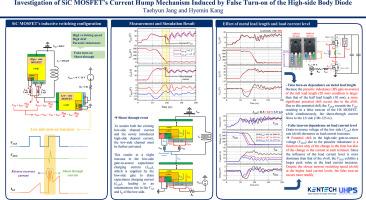高侧体二极管误导引起的SiC MOSFET电流驼峰机制研究
引用次数: 0
摘要
SiC mosfet由于其高速开关特性而广泛应用于高频领域。然而,随着开关速度的增加,器件的di/dt也会增加,这受到线键合和封装引线产生的寄生电感的高度影响。在半桥式电感开关结构中,虽然开关器件的误导通机理已经确定,但位移电流在高侧器件中流动,并通过主体二极管以自由转动方式工作,尚未确定。本文分析了半桥电路中由于高侧MOSFET在低侧导通瞬态过程中误导而导致的SiC MOSFET电流驼峰现象。此外,还分析了不同寄生电感和负载电流水平对高侧MOSFET误导通依赖性的影响。采用双脉冲试验验证了寄生电感引起的误导现象,并采用Sentaurus TCAD仿真分析了器件的内部行为。本文章由计算机程序翻译,如有差异,请以英文原文为准。

Investigation of SiC MOSFET’s current hump mechanism induced by false turn-on of the high-side body diode
SiC MOSFETs have been widely used in high-frequency applications due to their high-speed switching characteristics. However, as the switching speed increases, the di/dt of the device also increases, which is highly influenced by the parasitic inductance created by the wire bonding and the package leads. In the half-bridge inductive switching structure, while the false turn-on mechanism of the switching device is well established, the displacement current flows in the high side device, operating in freewheeling mode through the body diode, has not been identified. In this paper, the current hump phenomenon of the SiC MOSFETs, caused by the high side MOSFET’s false turn-on during the low side turn-on transient in a half-bridge circuit, was analyzed. In addition, the effect of the high-side MOSFET’s false turn-on dependence under different parasitic inductance and load current level was analyzed. Double pulse tests were used to confirm the false turn-on phenomenon due to the parasitic inductance, and Sentaurus TCAD simulation was used to analyze the internal behavior of the device.
求助全文
通过发布文献求助,成功后即可免费获取论文全文。
去求助
来源期刊

Power electronic devices and components
Hardware and Architecture, Electrical and Electronic Engineering, Atomic and Molecular Physics, and Optics, Safety, Risk, Reliability and Quality
CiteScore
2.00
自引率
0.00%
发文量
0
审稿时长
80 days
 求助内容:
求助内容: 应助结果提醒方式:
应助结果提醒方式:


